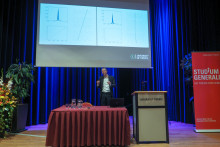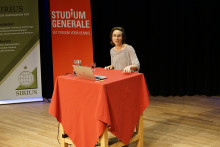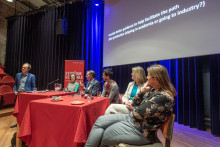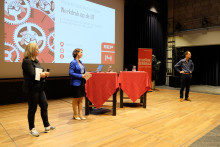Herman Offerhaus, a researcher in optical sciences at the UT, gave an insightful explanation of the research in the field of physics. Three scientists won the Nobel Prize in Physics this year: Arthur Ashkin, Gérard Mourou and Donna Strickland.
Lasers
Offerhaus first introduced the work of Mourou and Strickland. He started by explaining the concept of a laser and then worked his way around to explaining chirp pulse amplification. Offerhaus: ‘If you have two mirrors and in between them you have what is known as a gain medium, then the light that travels in between these mirrors gets stronger every time it passes through the gain medium. If one of the mirrors is transmitting, then the light comes out as laser light.’
‘Normally, the light comes out in different frequencies and if added up and spaced at regular intervals, a pulse is obtained. However, the peak intensities of these pulses that occur can become very high, if added and lined up together and can lead to the destruction of the gain medium. But, if a linear or quadratic phase change is introduced, the pulses are spread or stretched out to create short high-intensity laser pulses without destroying the gain medium.’

Sorting healthy cells
The work by Ashkin, as Dr Offerhaus puts it, ‘is quite different from the work of the other two scientists.’ ‘Light beams tend to exert force, which can move matter. However, this force is extremely small. Which is why photons of the sun don’t affect us when standing outside on a sunny day.’
‘But if the particles are extremely small and the laser beam is focussed, then the particles are attracted to the beam. And when the laser beam moves, the particles would follow it to stay in the focus of the beam. Thus, optical tweezers can be used to sort healthy cells from infected ones, or something that has been applied here at the university – stretching DNA.’
Enzymes and antibodies
Offerhaus was followed by professor Dick Janssen from the University of Groningen. He explained the research of the Nobel laurates in the field of Chemistry: Frances Arnold, Gregory Winter and George Smith. The research of Arnold focussed on the improvement of enzymes in terms of stability and activity. She used directed evolution or the Darwinian evolution, which involves creating genetic diversity and then selecting the best protein or the best phenotype.
Immunoglobulins were the focal point of the research conducted by Smith and Winter. This involves using phages to plant human antibodies on their surface and then using genetic diversity to create a multitude of antibodies after which the one that best suits the target protein is selected.

New player
In the field of medicine, Leonie Mekenkamp from Medisch Spectrum Twente, explained the concept of immunotherapy and its use in the treatment of cancer, based on the work of James P. Allison and Tasuku Honjo. Allison focussed on finding antibodies to block the protein CTLA4 and Honjo discovered the protein PD1. Both these discoveries form the basis of immunotherapy. Mekenkamps main conclusion: ‘Immunotherapy is a new player in the field of cancer.’
The annual Nobel Lectures are organized by the faculty of Science and Technology and Studium Generale. Eminent scientists explain the prize-winning research. The lectures have become a tradition since 2007.








